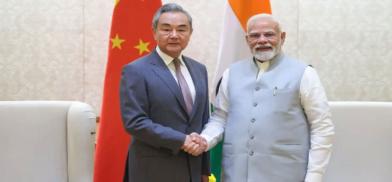Asia's Balance of Power Depends on India's Ability to Face China’s Strategic Challenge
Over the past decade, India’s strategic landscape has grown increasingly complex. Beijing has not diluted its consistent strategy of constraining India. Whether through deepening ties with Pakistan, or expanding influence in India’s periphery, China’s approach remains adversarial. Beijing’s assertive regional posture underscores the urgency for India to rethink both its economic and security policies.

The flurry of high-level diplomatic engagements between India and China this year – culminating in the visits of External Affairs Minister S. Jaishankar and Defence Minister Rajnath Singh to Beijing and of Chinese Foreign Minister Wang Yi to New Delhi have created an impression of a thaw in ties. There is talk of a possible visit by the Indian Prime Minister Narendra Modi to China, the first in seven years. Smiling photographs of handshakes suggest an attempt to “reset” relations. But beneath this veneer of bonhomie lies a far starker reality: India-China relations remain as fraught as they were in the wake of the 2020 Galwan clash.
Optimism about a reset with China is not new. Since the Ladakh clashes of 2020, umpteen rounds of military and diplomatic talks have been held, producing only partial disengagement and meaningless statements. Patrols remain restricted in some areas, infrastructure development by China continues apace, and the larger boundary dispute remains frozen. These visits and dialogues often create the illusion of forward movement, but they are essentially about managing a volatile situation rather than resolving it.
China’s rising assertiveness is no longer a distant worry - it is a direct challenge that India must confront with concrete action, not cautious diplomacy. Over the past decade, India’s strategic landscape has grown increasingly complex. Beijing has not diluted its consistent strategy of constraining India. Whether through deepening ties with Pakistan, or expanding influence in India’s periphery, China’s approach remains adversarial. Beijing’s assertive regional posture underscores the urgency for India to rethink both its economic and security policies. Diplomatic pleasantries do not change this calculus.
Taiwan and Tibet: Caution at the Cost of Prudence
Not long ago, India-Taiwan relations seemed poised for resurgence. Growing discontent with Chinese aggression and the natural synergy of two vibrant democracies offered scope for greater economic and strategic engagement. Sadly, despite early enthusiasm and immense promise, New Delhi’s outreach to Taipei has been overly cautious, and India has refrained from publicly signalling stronger ties with Taiwan. Even symbolic gestures such as sending a parliamentary representation at the Taiwanese presidential inauguration were quietly dropped. The muted trajectory of India-Taiwan relations underscores the limitations of India’s China policy.
The reasons are obvious: fear of provoking Beijing and jeopardizing an already fragile border situation. But this caution has come at a cost. India has missed opportunities to leverage Taiwan’s technological prowess, particularly in semiconductors, and to send a strategic message to China that coercion has consequences. In effect, India’s ‘no-risk’ approach has shaped outcomes as much as any external factor.
This approach was evident in India’s response to the official readout of the Chinese Foreign ministry on the recent Jaishankar - Wang Yi meeting. The Chinese in their press release surreptitiously inserted the line ‘Taiwan is part of China’ attributing it to Jaishankar. India issued a carefully worded statement emphasizing continuity in India’s position with respect to Taiwan and noting that China also engages Taiwan. While diplomatically sound, India’s choice not to directly challenge Beijing’s assertion raises questions: is this prudence, timidity, or tacit acceptance? No wonder, encouraged by India’s ambiguity, the Chinese have reacted with “surprise” at India’s “backtracking”.
The same hesitation is evident in India’s reluctance to leverage the Tibet issue diplomatically. New Delhi has consistently downplayed the Dalai Lama’s political significance to avoid antagonizing Beijing. This restraint dilutes India’s moral leverage and undercuts its global image as a defender of democratic freedoms. Some Indian journalists have even used the term ‘Xijang’, that Beijing uses, instead of ‘Tibet’. Beijing has thus, been allowed to shape the narrative, while India treads on eggshells, fearful of reprisals.
Economic Carrots & Tactical Concessions
Beijing, for its part, has mastered the art of offering tactical concessions to maintain the illusion of cooperation. Recent media reports of Chinese willingness to supply tunnel-boring machinery and rare earth minerals illustrate the lure of cooperation in areas India is deficient. However, the Chinese official spokesperson has not confirmed this so-called ‘offer’. This only reinforces the perils of relying on unverified Chinese promises. China holds the aces in our economic relationship, helped by a lopsided deficit in Beijing’s favour. Indian dependence on Chinese inputs for pharmaceuticals, electronics, and green energy is structural, and little has been done to correct it. Any Chinese gestures to loosen restrictions on exports to India are only calculated moves to perpetuate Indian dependence. Utmost strategic caution is necessary and India must treat them as tactical, not transformative, developments.
A Nation Unmoved
A lot has been written about China’s economic and military prowess as also its power differential with India. Instead of spurring India to close the gap in these fields, it has created a ‘defensive’ mindset, almost bordering on ‘acquiescence’ with China.
Why does this pattern of timidity persist? Part of the answer lies in public perception. Unlike Pakistan, which arouses strong emotions across the political and public spectrum, China does not occupy a comparable space in Indian public consciousness. Bilateral trade and limited media coverage of Chinese atrocities in Tibet and Xinjiang, further numbs public concern. Barring a few honourable exceptions, Indian industry, corporates and traders are content to continue importing cheap goods from China, that could either be manufactured in India or sourced from alternate countries. The average Indian consumer happily buys cheap Chinese goods, unaware that he is indirectly paying for Beijing’s military modernisation against India and fuelling its economic clout.
Even within strategic circles, open opposition to China is subdued. Some analysts fear that overt criticism may jeopardize engagement channels. Others remain overly optimistic that economic pragmatism will eventually soften Beijing’s stance. Academic and think-tank debates often couch criticism of China in cautious language, preferring “balance” and “dialogue” over forthright assessments. This reluctance has produced a strategic culture that underestimates China’s challenge.
Diplomacy Without Solutions
India’s diplomats, too, have struggled to produce tangible outcomes in dealing with China. Much of the engagement has revolved around preventing escalation, issuing statements, photo-ops of handshakes and maintaining working-level dialogue. But the structural problems remain untouched. Does the subdued stand of Indian envoys arise from the fear of border flare-ups, a lack of leverage in negotiations, and an ingrained belief that engagement may avoid confrontation? This type of diplomacy has produced little beyond temporary disengagements and vague statements about “mutual respect” but has not resolved challenges.
It is against this backdrop that Prof. Jabin Jacob’s description of Indian policy being “at a crossroads” rings true. The irony of the current push to normalize ties is that it brings India no tangible gains. Instead of hard bargains, what we see is an implicit acceptance of Chinese terms. Nothing illustrates this better than the fact that Indian citizens have not yet been informed whether the “status-quo ante” as on April 2020 has been restored.
Hard Options for India
If India is to safeguard its interests, it must move beyond cosmetic diplomacy and embrace hard but effective options. Some of these are:
1. Energize Quad and deepen strategic partnerships with Japan, Australia, South Korea, Philippines and Vietnam. India needs to be ‘seen’ and ‘heard’ more often in the Indo-Pacific.
2. Economic De-risking: Reducing dependence on Chinese imports must become a national priority. This requires targeted investment in domestic manufacturing, diversification of supply chains, and incentives to attract Taiwanese, Japanese, Korean and other global firms in critical tech sectors.
3. Leveraging Tibet and Taiwan: Without abandoning caution, India can subtly elevate its engagement with Taiwan and provide more visible support to Tibetan cultural and human rights causes. This would signal to Beijing that pressure tactics have costs.
4. Enhance Military Capability: Ongoing efforts in this field need to be accelerated. Indigenous efforts should run in tandem with global partnerships towards developing capabilities in the aerospace, maritime, cyber and informational domains.
5. Narrative Building: India must also invest in shaping the domestic and international narrative about China’s coercion. Public awareness campaigns, think-tank research, and media should amplify the reality of China’s aggressive posture and the threat it poses to India. Greater transparency is necessary to inform the Indian public about the situation on the India-Tibet border and Chinese human rights violations in Tibet and Xinjiang.
India's China Challenge Here to Stay
In an era where coercion, misinformation, and grey-zone tactics increasingly define statecraft, India cannot rely solely on diplomacy or international norms. Diplomacy cannot substitute for the tangible demonstration of capability and resolve. The challenge from China is neither temporary nor transactional; it is structural and enduring. Diplomatic visits and symbolic concessions may provide temporary relief but do not alter Beijing’s fundamental approach. India cannot afford to be lulled by optics or subdued into silence.
The stakes are high. Asia’s balance of power, India’s economic and technological growth, and regional stability all hinge on India’s ability to respond decisively to strategic challenges. Action, not ambivalence, will define India’s credibility in the years ahead and its place in a rapidly evolving regional order. In the end, the real test of statecraft is not in how often leaders meet or how warmly they smile, but in how effectively a nation safeguards its sovereignty and secures its future. India’s China challenge is here to stay. The question is whether New Delhi is prepared to confront it with the clarity, courage, and conviction it demands. For too long, the Chinese have kept the heat on India. It is time for India to reciprocate.
(The author, an Indian Air Force veteran, served in various command, instructional and staff appointments for over 32 years and writes on geopolitics, international relations and defence issues. Views expressed are personal. His X (formerly Twitter) handle is @aparagonpilot and email praveerp@rediffmail.com )
Being coercive is probably in China's doctrine.
So we shall have to think like China to engage on any subject with China.










Post a Comment